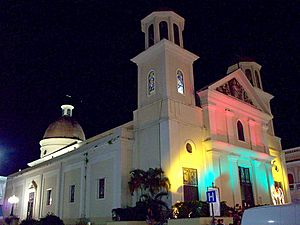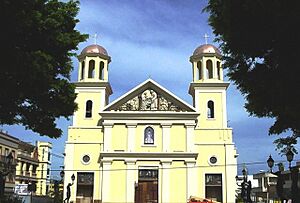Catedral Nuestra Señora de la Candelaria (Mayagüez, Puerto Rico) facts for kids
Quick facts for kids Catedral de Nuestra Señora de la Candelaria |
|
|---|---|
 |
|
| 18°12′04.00″N 67°08′17.68″W / 18.2011111°N 67.1382444°W | |
| Location | Calle Candelaria, Plaza Colón, Mayagüez, Puerto Rico |
| Denomination | Roman Catholic |
| History | |
| Status | Cathedral |
| Consecrated | 1763 |
| Architecture | |
| Style | Spanish Revival some Art Deco tones |
| Groundbreaking | 1763 |
| Completed | 2004 |
| Specifications | |
| Length | 51.26m |
| Width | 23.54m |
| Administration | |
| Diocese | Diocese of Mayagüez |
The Catedral Nuestra Señora de la Candelaria, also known as Our Lady of the Candelaria Cathedral, is a very important cathedral in Mayagüez, Puerto Rico. It is the main church for the Roman Catholic Diocese of Mayagüez. You can find it at the eastern end of the Colón Main Square, right across from the town hall.
Contents
History of the Cathedral
Early Beginnings and First Buildings
The very first church on this spot was built from wood in 1763. This was just three years after the city of Mayagüez was founded. The land for the church was given by Don Juan de Aponte and Don Juan de Silva.
In 1780, a stronger building made of stone was put up. This first stone church looked more traditional than the one you see today. It had a large, flat triangular part above the main entrance. The church also featured two tall, eight-sided towers. Vicente Piera was the architect who designed it in 1833.
Many important people were connected to this church. For example, Doña Ama Mariana Bracetti Cuebas was baptized here on August 29, 1825. Don Eugenio María de Hostos, another famous person, was also baptized here on April 12, 1839.
Challenges and Rebuilding Efforts
The church faced some tough times. In 1854, lightning struck one of its right towers, damaging it. The tower was later fixed. Then, in 1870, the entire building was repaired and made new again.
On November 10, 1900, Jose de Diego had his wedding ceremony at the church.
A big earthquake, called the 1918 San Fermín earthquake, hit on October 11, 1918. It completely destroyed one tower and badly damaged the other. What was left of the towers had to be taken down using dynamite.
After the earthquake, people decided to build a new church. Architect Don Luís Perocier made plans in 1920, but they were not fully used. The church that was built still looked similar to his ideas. The new construction started in 1922, led by architect Don Luís F. Nieva.
Becoming a Cathedral and Modern Renovations
In 1976, Pope Paul VI allowed the creation of the Diocese of Mayagüez. This meant the church became a cathedral soon after. A few years later, the first bishop of the city, Mons. Ulises Casiano Vargas, started a project to remodel the cathedral.
The remodeling aimed to follow Perocier's original design, including building two towers. Carlos Juan Ralat was the architect for this big project. The renovation cost about $3.5 million and took around two years to finish. It was supposed to take one year, but there were delays. The roof was in bad shape, and old crypts (underground burial places) were found.
Among the remains found in the crypts were those of some of Mayagüez's founders, like Don Faustino Martínez and Don Lorenzo Martínez Matos. The newly remodeled cathedral reopened on January 1, 2004. Representatives from the Vatican were there for the special event.
Waters of Liberty: A Story of Freedom
The Catedral Nuestra Señora de la Candelaria holds a special place in history because of something called "aguas de libertad" (waters of liberty). In the 1800s, two brave men, Segundo Ruiz Belvis and Ramón Emeterio Betances, were part of a secret group that worked to end slavery.
They used the church's baptismal font to help free thousands of enslaved Black children. Here's how it worked: If an enslaved child was baptized, their freedom could be bought for 50 pesos. If they hadn't been baptized, it cost 25 pesos.
Betances and his friends would wait by the baptismal font on Sundays. When an enslaver brought a family to baptize their child, Betances or his partners would give money to the parents. The parents would then use this money to buy their child's freedom from the enslaver. Right after being freed, the child would be baptized. This act was known as receiving the "waters of liberty."
The original baptismal font used for these special baptisms still exists today. It is owned by a local family of merchants, the Del Moral family, who keep it safe in their home in Mayagüez.
See also
 In Spanish: Catedral de Nuestra Señora de la Candelaria (Mayagüez) para niños
In Spanish: Catedral de Nuestra Señora de la Candelaria (Mayagüez) para niños
- Catholic Church in Puerto Rico
- History of Mayagüez
- List of cathedrals in the United States
- List of Catholic cathedrals in the United States
- Roman Catholic Diocese of Mayagüez
- Virgin of Candelaria




